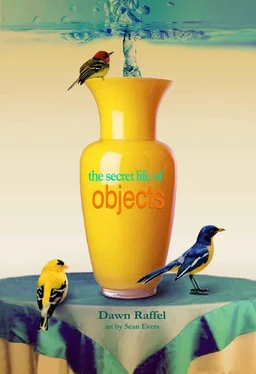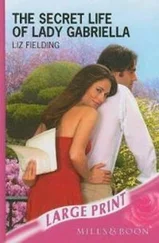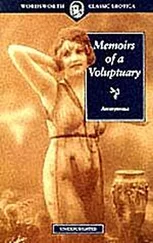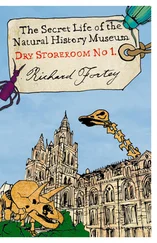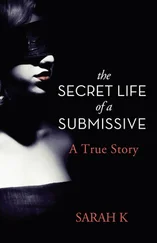
One day when he was 101 years old, my Grandfather Raffel took the vase off the windowsill in his house and gave it to me. That vase had sat in the living room window for as long as I could remember. It is luminous blue, with an oval portrait of a lady painted on it.
He told me he’d bought the vase from the man moving out of the apartment into which my grandfather was moving his own young family. This was toward the end of the Depression. The man’s wife had committed suicide. Desperate for cash, he was selling her things, including the vase, already antique, or at the least, old. My grandfather, who’d been poor himself, told me he bought it out of pity for that broken, broke man.
He handed it to me.
My grandfather died the following year at 102. (“It all went by so fast,” he said, not long before he drew his final breath.)
The vase sits on the top shelf of my floor-toceiling bookcase — too high too reach, or break. Every day I see that face, surrounded by luminous blue. The woman is serene, young; her brown curls lustrous, falling as they may. Above a diaphanous gown, her bosom swells. She gives away nothing.
The vase — blue, pottery — I guess blue is my color — was a gift from my college boyfriend. We’d drifted apart and become just friends for a few years and sometimes we wrote and sometimes we called and we invited each other to our weddings in cities four hours apart and neither of us went to the other’s wedding and we sent each other presents. We mailed Christmas cards and then we didn’t. When my husband and I were selling our last apartment in Manhattan, a woman who answered our ad turned out to be the roommate of the old boyfriend’s sister, and I asked her to say hello and she said she would. The vase sat on the windowsill of my house for a long time, along with a whole collection of pottery and glass. When the kids were toddlers I put everything away, and now that they’re older, I have other vases there.
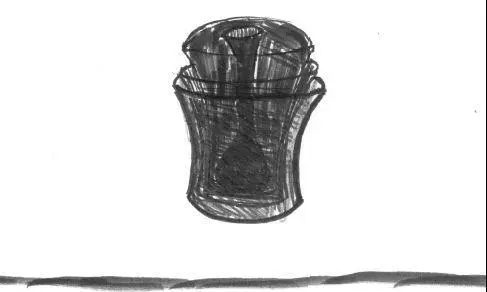
My mother bought the nesting bowls — four glass pieces that fi t perfectly into each other’s fl ared shape — shortly before her death. She called me from her cell phone to tell me that she had just placed them in blankets in the trunk of her car. She had bought them from the Hungarian woman who made them. (“She’s 90 years old!” my mother said.) Even on her phone that was breaking up across the hundreds of miles between us, I could hear how happy my mother was about those bowls.
My mother kept the bowls — which aren’t really bowls at all, and are not meant to contain anything save air, light and each other — on a mirror in the center of her dining room table. Their color is blue, close to cobalt. They are heavy.
I took the bowls when my mother died, shipped them wrapped in yards of protective material to my home, to my dining room table. The bowls could use a dusting. I have lost the pamphlet explaining the artist’s work; in fact I don’t remember the woman’s name.
It’s possible she’s still alive.
The China Tree That Looks Like My Grandfather’s China Tree
That we were Jewish didn’t stop my family from pining after Christmas decorations. My parents would pile my sister and me into the car to drive around Milwaukee looking at displays of lights, Santas, reindeer, and angels. My Grandma Raffel hung stockings for us on her mantel. At Raffel’s, the family furniture store, the Christmas tree was a business decision, my father said; customers expected it. The rule — unspoken but clearly conveyed — was, you didn’t deny being Jewish but you didn’t advertise it either. My sister and I would scheme, sometimes successfully, to be in the store on the day the tree was decorated, as a business decision.
My mother’s family in Chicago was more overtly Jewish. While my Grandfather Raffel had been born into American poverty, Grandpa Bern had been raised a few hours from Budapest, one of seven children. His father had been a scholar, or, as my grandfather said bitterly, a man who never supported his family — although he did make and sell hand-turned wooden spice boxes and candlesticks, two of which I have. His mother was a milliner and grew the family’s vegetables.
When I was 12, I made two attempts to get my grandfather to record his story, which my grandmother typed up on her manual typewriter (that later became my manual typewriter). The first version, beginning with “As per your request”—my grandmother’s locution — had only to do with Jewish village life (“We had a parochial school where both Hebrew and Hungarian were taught… This was a fully accredited school, from which you could enter gymnasium after six years. This was compulsory, thanks to our King Franz Joseph…”). The second version told of leaving school at 13 to be apprenticed to a dry goods merchant. In 1913 he was to be drafted into the army in the service of Russia—“which resembles slavery,” he wrote. It was illegal for him to leave, but he figured he’d choose capture over what he saw as certain death.
An old man who lived down the road from him, a cantor, bought a ticket and boarded a train to Germany, passed inspection, and in the last moment before the doors shut, jumped off the train, switching places with my grandfather, who was waiting on the platform. I do not know what befell that cantor. Most likely he survived the subterfuge — less likely the coming influenza epidemic and the war. My grandfather, in an alternate route to the American immigrant dream, traveled by train across Europe, by ferry to Liverpool, by steamer to Canada, and by train to Chicago, where his older sister had already settled. (His American name — Bert Bern — was decided upon by his sister, her husband, and assorted cousins; he later said, with some bemusement, “I wasn’t given a say.”) In Chicago he worked a series of jobs, starting as floor sweeper, learned to write English mostly phonetically, and opened a Florsheim shoe store, if you will, on a shoestring. He told us years later that if he had not sold his entire inventory in his first week, he would not have been able to pay the rent, and would have been out of business.
My grandfather spent five days a week measuring men’s feet with a metal slide and then going to the neat stacks of boxes in the back room to select the proper oxford or wingtip, pinching the toe box to check for optimal wiggle room. Any time he came to our house in Milwaukee, he would start his visit by examining our shoes, turning them over and over in his big red hands, grudgingly approving the saddle shoes, suspicious of the penny loafers, contemptuous of Keds (“Vot are these? You call these shoes?”).
When it was our turn to visit Chicago, he would leave us with our grandmother on Saturday morning and walk alone to an old shul. Just as he refused ever to leave “The Blessed USA”—no visits to the old country for him, no sir, and you could keep Paris and London too — he refused to forget that he was a Hungarian Jew. His accent clung to him. (His favorite word was “alamash!”—I am not sure what this meant in his native tongue but over the years it became an all-purpose imperative for anything from “Let’s go!” to “Change the subject!” to “Enough already!” and, on occasion, “Let’s eat!”) He believed in ritual. Visit at Passover and you were likely to pass out before the prayers ended and the food was served.
Читать дальше
